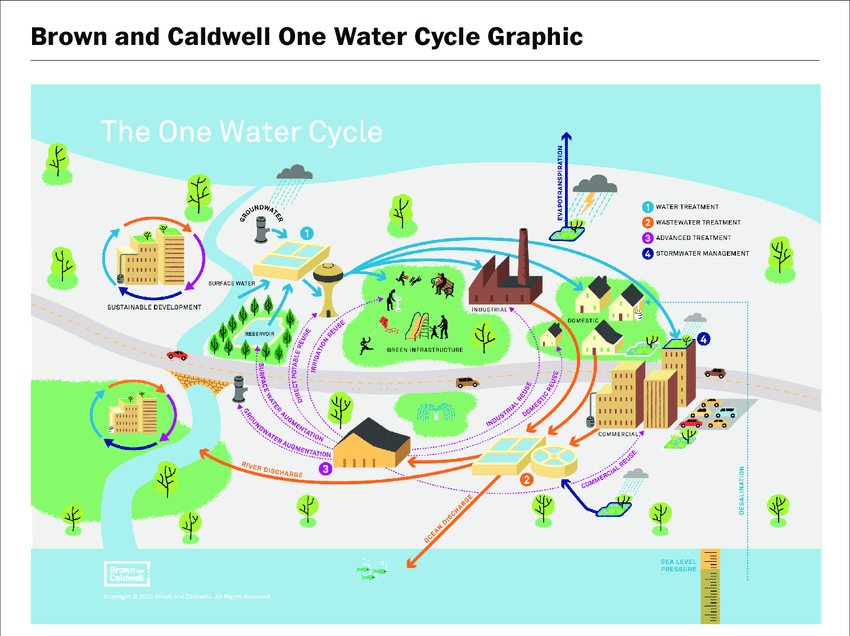Image Source: One Water Cycle graphic provided by Brown and Caldwell, © 2020 Brown and Caldwell. All rights reserved.
Water Cycle Series: From rainfall to drinking water systems, this series will explore how the natural and built environment impact the water cycle. This entry is the first in a series of blogs to highlight the interconnectedness of water systems. Please follow along as we explore watersheds, drinking and wastewater systems, and the role we all play in the quality of our water and the health of our communities!
Nature provides water, but it takes pipes, pumps, and infrastructure to complete the one water cycle, specifically drinking water and wastewater.
In part 1 of the Water Cycle Series blog series, the role of the watershed is explained, how it is part of the water cycle, and why its health is vital to our water bodies that supply drinking water. In this part 2 of our series, learn the next stage of the water cycle and the infrastructure that supports it. One water is the belief that water in all its forms is vital and has value, be it as water in watersheds, drinking water, wastewater, or stormwater.
Watershed drains water into a water body/ water source. Drinking water utilities source their water from these water bodies/water sources. Broadly, the types of water bodies from which drinking water utilities source their water include surface water (reservoir or lake), groundwater (an aquifer), and recycled water (also called reused water). Jersey WaterCheck’s system finder tool helps you find out who your drinking water system is and where it sources the drinking water from. For example, Aberdeen-Cliffwood/Cliffwood Beach system sources some of its water from the “ Middle Potomac-Raritan-Magothy aquifer.” Once sourced, water undergoes treatment to make it potable or safe to drink. Check out this mini video JWC that explains how water systems make water more potable (safe to drink). Water utilities are essential public health infrastructure and work 24/7 to ensure water is safe to drink. Multiple JWC metrics under the category “ How Well is my System Meeting Drinking Water Regulatory Requirements” help explain how your drinking water system is meeting regulatory standards. From Jersey Water Check, as seen in Figure 1 below, across 2015-2021 years, 94-95 percent of water utilities are meeting primary drinking water standards.
Figure 1: JWC Screenshot of Primary Drinking Water Standards (click for full image)

Water once used in bathrooms and kitchens drains out as wastewater. Wastewater goes through pipes to a wastewater treatment plant, which treats it and then discharges it into a water body. Jersey WaterCheck’s system finder tool helps you find who your wastewater system is and where it discharges its treated wastewater. For example, the Bayshore Regional Sewerage Authority discharges treated wastewater into the Atlantic Ocean. This mini video by JWC explains how wastewater is treated before it is discharged. The JWC metric “ Met Effluent Discharge Quality Standards” illustrates how a wastewater system meets regulatory quality standards. Data in Figure 2 below across the 2017-2021 years show that 90-97 percent of wastewater systems meet wastewater effluent treatment standards.
Figure 2: JWC Screenshot of Met NJ Effluent Discharge Quality Requirements (click for full image)

Water connects us all. Water in all its forms, be it watershed, stormwater, drinking water, or wastewater, has value and impacts the health and well-being of all.
Missed Part 1 of our series? Read it here: Water Cycle Series Part 1: What is a Watershed?
This blog was written by Jyoti Venketraman, who oversees Jersey WaterCheck and serves as a backbone staff in the Data Advisory Committee and the Asset & Management Committee.
Visit Jersey WaterCheck here: https://www.njwatercheck.com/.
